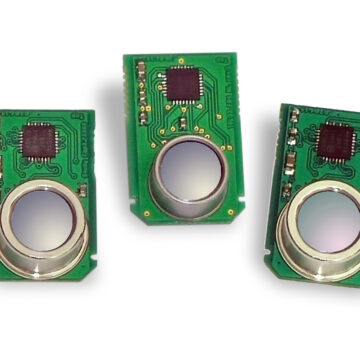1. Understanding the Basics of Infrared Sensor Arrays
Unveiling the Power of Infrared Technology
Infrared technology has revolutionized the way we interact with our surroundings. It allows us to perceive and detect objects that are otherwise invisible to the naked eye. Infrared radiation is simply electromagnetic radiation with longer wavelengths than visible light. This technology has found widespread applications in various fields, from industrial to medical, and one of its key components is the infrared sensor array.
What Are Infrared Sensor Arrays and How They Work
An infrared sensor array is a collection of multiple individual infrared detectors arranged in a grid-like pattern. These detectors, often made of advanced materials such as mercury cadmium telluride (MCT) or indium antimonide (InSb), can detect infrared radiation and convert it into electrical signals. The signals are then processed to generate images or provide information about temperature variations.
One of the main advantages of using a sensor array is its ability to capture images or gather data from multiple points simultaneously. This allows for more accurate and detailed analysis, especially in applications where rapid detection or high resolution is required.
The Advantages of Utilizing Infrared Sensor Arrays
Infrared sensor arrays offer several distinct advantages over traditional single-point detectors. Firstly, their grid-like arrangement provides a wider field of view, enabling the detection of objects or phenomena across a larger area. This is particularly valuable in surveillance systems or monitoring applications where comprehensive coverage is crucial.
Secondly, the use of multiple detectors allows for improved sensitivity and accuracy. By combining the outputs of individual detectors, sensor arrays can mitigate noise, enhance signal strength, and reduce false alarms. This is especially important in applications such as medical diagnostics or security systems, where precise and reliable measurements are essential.
Lastly, infrared sensor arrays offer the possibility of capturing thermal images or conducting thermographic analysis. By detecting temperature variations across a surface, they can identify anomalies or hotspots that may indicate faults, inefficiencies, or potential dangers. This capability has significant implications in industries such as energy, manufacturing, and building maintenance.
2. Exploring the Revolutionary Applications of Infrared Sensor Arrays
Revamping the Automotive Industry with Infrared Sensor Arrays
Infrared sensor arrays are revolutionizing the automotive industry by enhancing safety and driving assistance systems. They are commonly used in advanced driver-assistance systems (ADAS) to detect and track vehicles, pedestrians, and obstacles. By continuously monitoring the surroundings, these sensors provide real-time information to help the vehicle make informed decisions and avoid collisions.
Infrared sensor arrays are particularly effective in low-light or adverse weather conditions, where visibility is limited. They can penetrate fog, smoke, or dust, allowing for reliable detection even when other sensors may fail. Additionally, their ability to capture thermal images can assist in detecting the heat signatures of objects or living beings, further improving safety measures.
The Future of Security Systems: Infrared Sensor Arrays and Surveillance
Infrared sensor arrays are transforming the field of security and surveillance. With their ability to detect and distinguish heat signatures, they can accurately identify people, animals, or vehicles in both indoor and outdoor environments.
By integrating infrared sensor arrays into surveillance systems, security personnel can monitor large areas with enhanced precision. The sensors can detect movement and changes in temperature, triggering alerts and allowing for proactive responses to potential threats.
Furthermore, the use of thermographic cameras and infrared sensor arrays in border control and perimeter protection has proven to be highly effective. These sensors can detect individuals attempting to cross unauthorized boundaries, even in complete darkness. By combining infrared technology with intelligent algorithms, security systems can achieve unprecedented levels of accuracy and reliability.
Enhancing Medical Diagnostics with Infrared Sensor Arrays
Infrared sensor arrays have opened up new possibilities in the field of medical diagnostics. Their ability to detect and measure temperature variations makes them valuable tools in identifying and assessing various medical conditions.
Infrared thermography, enabled by sensor arrays, is used for early detection of breast cancer by capturing temperature differences in breast tissue. It can also assist in diagnosing vascular disorders, sports injuries, and deep vein thrombosis, among others. These applications provide non-invasive and painless alternatives to traditional diagnostic methods.
Infrared sensor arrays are also used in monitoring patients’ vital signs, such as body temperature, respiratory rate, and heart rate. Their accuracy, speed, and non-contact nature make them particularly suitable for continuous monitoring in critical care environments.
3. Overcoming Challenges and Limitations of Infrared Sensor Arrays
The Importance of Calibration in Infrared Sensor Arrays
Accurate calibration is essential for ensuring the reliability and precision of infrared sensor arrays. Calibration involves adjusting the sensor’s response to match a known standard, thereby eliminating any deviations or errors. It ensures consistent and accurate measurements, making the sensors suitable for critical applications.
Regular calibration is necessary to compensate for drift or aging effects that may occur over time. It is also crucial when using multiple sensor arrays in a network or system, as it ensures uniformity and consistency across all sensors.
Addressing False Alarms: Fine-Tuning Infrared Sensor Arrays
Infrared sensor arrays are incredibly sensitive and can trigger false alarms if not properly fine-tuned. Factors such as changes in environmental conditions, reflections, or interference from other heat sources can lead to erroneous detections.
To minimize false alarms, sophisticated algorithms and signal processing techniques are employed. These algorithms analyze the captured data, filtering out irrelevant signals and identifying patterns that signify genuine threats. Continuous fine-tuning and improvement of these algorithms are crucial to maintain high accuracy and minimize unnecessary interruptions caused by false alarms.
Potential Drawbacks and How to Mitigate Them
While infrared sensor arrays offer numerous benefits, they are not without limitations. One such limitation is their inability to penetrate certain materials, such as metals or dense objects. This can pose challenges in certain applications where the detected objects or phenomena may be obscured or partially concealed.
Additionally, the cost of infrared sensor arrays can be a limiting factor, particularly for small-scale or budget-constrained projects. However, advancements in technology and manufacturing processes are gradually driving down the costs, making these sensors more accessible and affordable.
To mitigate these limitations, techniques such as multi-sensor integration, data fusion, and advanced imaging algorithms are employed. These approaches enhance the overall performance and broaden the range of applications for infrared sensor arrays.
4. Innovations on the Horizon: Advancements in Infrared Sensor Arrays
Breakthrough Technologies in Infrared Sensor Array Manufacturing
Ongoing research and development in the field of infrared sensor array manufacturing are driving significant advancements. Researchers are exploring new materials, fabrication techniques, and integration methods to enhance performance and reduce production costs.
One of the promising areas of focus is the development of microbolometer-based sensor arrays. Microbolometers are highly sensitive infrared detectors made from microfabricated structures. They offer several advantages, including low cost, low power consumption, and compatibility with CMOS technology. These advancements are paving the way for the widespread adoption of infrared sensor arrays in various industries.
The Future Outlook: Miniaturization and Integration
The future of infrared sensor arrays lies in miniaturization and integration. As technology progresses, sensors are becoming smaller, more compact, and capable of fitting into smaller form factors. This opens up new possibilities for integrating them into wearable devices, IoT systems, and even smartphones.
Additionally, the integration of infrared sensor arrays with other sensors, such as visible light cameras or lidar systems, holds great potential. Combining different sensing modalities allows for comprehensive data collection and analysis, enabling applications such as object recognition, scene understanding, and augmented reality.
Exploring the Future Potential of Infrared Sensor Arrays
The future potential of infrared sensor arrays is vast and promising. As technology continues to evolve, we can expect further improvements in sensitivity, resolution, and performance. This will unlock new applications and opportunities in areas such as autonomous vehicles, smart homes, precision agriculture, and environmental monitoring.
Furthermore, advancements in artificial intelligence and machine learning can further enhance the capabilities of infrared sensor arrays. These technologies enable more sophisticated analysis and interpretation of the collected data, leading to greater insights and actionable information.
In conclusion, infrared sensor arrays are a visionary breakthrough that has revolutionized technology across various industries. Their ability to detect and analyze infrared radiation has enabled groundbreaking applications in automotive safety, security systems, medical diagnostics, and more. While they come with challenges and limitations, continuous advancements in manufacturing and integration techniques promise a bright future for infrared sensor arrays. As we move forward, these sensors will continue to shape and transform our technological landscape.
FAQ
Question: What is an infrared sensor array? – An infrared sensor array is a collection of multiple individual infrared detectors arranged in a grid-like pattern. These detectors can detect infrared radiation and convert it into electrical signals, allowing for the capture of thermal images or the gathering of data from multiple points simultaneously.
Question: What are the advantages of utilizing infrared sensor arrays? – Infrared sensor arrays offer several advantages over traditional single-point detectors. They provide a wider field of view, improved sensitivity and accuracy, and the ability to capture thermal images. These features make them valuable in applications such as surveillance systems, medical diagnostics, and automotive safety.
Question: How do infrared sensor arrays enhance automotive safety? – Infrared sensor arrays are used in advanced driver-assistance systems (ADAS) to detect and track vehicles, pedestrians, and obstacles. They can penetrate low-light or adverse weather conditions, providing real-time information to help vehicles make informed decisions and avoid collisions.
Question: What are the applications of infrared sensor arrays in security systems? – Infrared sensor arrays are transforming the field of security and surveillance. They can accurately identify heat signatures, allowing for the detection and distinction of people, animals, or vehicles in both indoor and outdoor environments. This capability enhances monitoring and perimeter protection.
Question: How do infrared sensor arrays contribute to medical diagnostics? – Infrared sensor arrays can detect and measure temperature variations, making them valuable tools in medical diagnostics. They are used in applications such as early detection of breast cancer, diagnosing vascular disorders, and monitoring patients’ vital signs in critical care environments.
Question: What are the limitations of infrared sensor arrays? – Infrared sensor arrays may have limited penetration through certain materials and can be costly. However, these limitations can be mitigated through techniques such as multi-sensor integration, data fusion, and advanced imaging algorithms.
Question: What are some future advancements in infrared sensor arrays? – Ongoing advancements in infrared sensor array manufacturing include the exploration of new materials, fabrication techniques, and integration methods. The future outlook involves miniaturization, integration with other sensors, and unlocking new applications in areas such as autonomous vehicles, smart homes, and precision agriculture.
Question: How can artificial intelligence enhance the capabilities of infrared sensor arrays? – Artificial intelligence and machine learning technologies can enhance the analysis and interpretation of the collected data from infrared sensor arrays. This enables more sophisticated insights and actionable information, further expanding the potential applications of these sensors.
Useful Resources:
- Infrared Thermography: Learn more about the principles and applications of infrared technology, including infrared sensor arrays.
- Advancements in Infrared Sensor Array Manufacturing: Explore the latest research and developments in manufacturing techniques for infrared sensor arrays.
- Applications of Infrared Sensor Arrays in Medical Diagnostics: Read about the various medical applications of infrared sensor arrays, from early cancer detection to vital sign monitoring.
- Integration of Infrared Sensor Arrays with Other Sensors: Discover the potential benefits and applications of integrating infrared sensor arrays with other sensing technologies.
- Thermography-Based Security Systems with Infrared Sensor Arrays: Learn about the advancements in security systems utilizing infrared sensor arrays for surveillance and perimeter protection.
- Artificial Intelligence Enhancements for Infrared Sensor Arrays: Explore how artificial intelligence can enhance the capabilities of infrared sensor arrays for data analysis and interpretation.
- Miniaturization and Integration of Infrared Sensor Arrays: Read about the future prospects of miniaturizing and integrating infrared sensor arrays into wearable devices and IoT systems.
- Advancements in Infrared Detector Technology: Stay updated on the latest advancements in infrared detector technology, including the latest developments in detector materials and fabrication techniques.


















